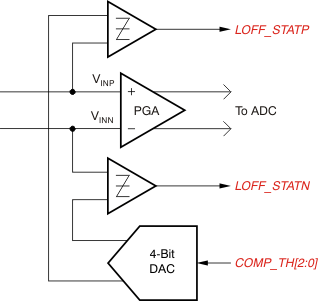SBAU171D May 2010 – January 2016 ADS1198 , ADS1298
-
ADS1298ECG-FE/ADS1198ECG-FE
- Trademarks
- 1 ADS1298ECG-FE/ADS1198ECG-FE Overview
- 2 Quick Start
- 3
Using the ADS1298ECG-FE Software
- 3.1 Application User Menu
- 3.2 Top-Level Application Controls
- 3.3 About Tab
- 3.4 ADC Register Tab
- 3.5 Analysis Tab
- 3.6 Save Tab
- 4 ADS1x98ECG-FE Input Signals
- 5 ADS1298ECG-FE/ADS1198ECG-FE Hardware Details
- ASchematics, BOM, Layout, and ECG Cable Details
- BExternal Optional Hardware
- CSoftware Installation
3.4.3.1 Lead-Off Detection and Current Direction Control Registers
The first two arrays of controls (Lead Off Sense) enable lead-off detection for both the positive and negative channels, LOFF_SENSP and LOFF_SENSN. By pressing the buttons, lead-off detection is enabled for each channel individually and for each input (positive and negative). Set All LOFFP Bits and Set All LOFFN Bits allow the user to turn on or off all the enable bits at once instead of clicking each individual channel control.
The third array of controls (Lead Off Current Direction) determines the current direction used for lead-off detection when an excitation signal is selected as a pull-up/pull-down resistor. Each channel is controlled individually by selecting the button that corresponds to the desired channel to manipulate. When the button is not illuminated, LOFF_FLIP = 0 (INP is pulled-up to AVDD and INN is pulled-down to ground). When the button is pressed/illuminated, LOFF_FLIP = 1 (INP is pulled-down to ground and INN is pulled-up to AVDD). Further details of these registers and lead-off function are located in the Applications Section of the device data sheet.
Figure 10 describes the mode for Lead-Off Detection (that is, resistive or current source) and the 4-bit DAC settings to configure the lead-off threshold. Figure 13 illustrates the connections from the positive and negative inputs to the lead-off comparators. The output of the comparators is viewed by using Show/Poll Lead Off Status control as described in Section 3.2
 Figure 13. LOFF_STATP and LOFF_STATN Comparators
Figure 13. LOFF_STATP and LOFF_STATN Comparators